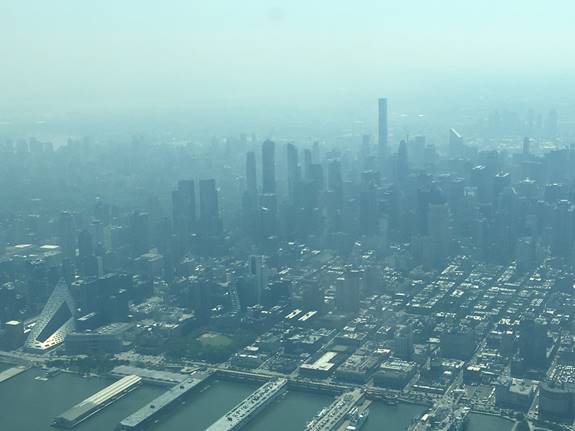ARL Weekly News – July 6, 2018
HQ

Severe haze over New York City on July 2, 2018 as seen from the University of Maryland’s research aircraft. Credit: NOAA
Long Island Sound Tropospheric Ozone Study (LISTOS): ARL’s air pollutant-measuring equipment, aboard the University of Maryland’s research aircraft, flew over the New York City and Long Island Sound area on July 2 during an episode of the worst air quality in over 10 years, with severe haze and high concentrations of ozone. Measurements taken included ozone, nitrogen dioxide and other air pollutants, with a goal to further understanding of the contributing chemicals, their emission sources, and the underlying weather patterns that influence their movement. The highest ozone concentration of ~150 parts per billion (ppb) was observed during the flight and was consistent with air quality monitors on the surface, where the highest 8-hour average ozone concentration of 115 ppb was reported at a site downwind of New York City; exceeding the current EPA 8-hour average ozone standard of 70 ppb. LISTOS is an ongoing, multi-agency collaborative research project involving NOAA, the Northeast States for Coordinated Air Use Management (lead), U.S. EPA, NASA, state environmental agencies from New York, New Jersey, Connecticut, and Maine, and several universities. The study is focusing on the Long Island Sound because the region perpetually suffers from high ozone concentrations and resulting poor air quality that negatively affects the health and well-being of over 20 million people from the New York City metropolitan area to the Atlantic coast of Massachusetts. More information is available at http://www.nescaum.org/documents/listos.
A paper titled “Vertical distributions of aerosol optical properties during the spring 2016 ARIAs airborne campaign in the North China Plain,” co-authored by Fei Wang, Zhangqing Li, Xinrong Ren et al., has been published in Atmospheric Chemistry and Physics. In this study, aerosol optical profiles are characterized for the first time over the North China Plain (NCP) by aircraft measurements. Statistical summaries of the vertical distributions of aerosol optical properties focused on four target areas in the NCP region. Three typical planetary boundary layer (PBL) structures were found and the aerosol scattering coefficients showed different correlations with ambient relative humidity during the field campaign. The air mass back trajectories of three PBL structures were also discussed. The paper is available at: https://www.atmos-chem-phys.net/18/8995/2018/

